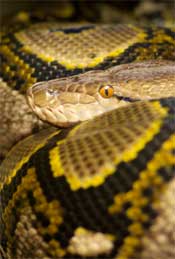|

 A New World Record!: Pythons range in size from 4.5 to 6 meters (15 to 20 feet) in length.
They are among the longest species of snake in the world; according
to the Guinness Book of World Records the Reticulated Python holds
the record for longest snake, at 10m (32ft 9.5in). A New World Record!: Pythons range in size from 4.5 to 6 meters (15 to 20 feet) in length.
They are among the longest species of snake in the world; according
to the Guinness Book of World Records the Reticulated Python holds
the record for longest snake, at 10m (32ft 9.5in).
Some species exhibit vestigial bones of the pelvis and rear legs,
which are externally apparent in the form of a pair of anal spurs
on each side of the cloaca. These spurs are larger in males than
females, and are used by the male to stimulate the female during
copulation. Pythons are distinguishable from boas in that they have
teeth on the premaxilla, a small bone at the very front and center
of the upper jaw.
Some pythons display vivid patterns on their scales while others
are a nondescript brown. They usually reflect appropriate camouflage
for their native habitat.

 How about a hug?: Pythons are constrictors, and feed on birds and mammals, killing
them by squeezing them to death. They coil themselves up around
their prey, tighten, but merely squeeze hard enough to stop the
prey's breathing and/or blood circulation. Large pythons will usually
eat something about the size of a house cat, but larger food items
are not unknown. They swallow their prey whole, and take several
days or even weeks to fully digest it. Despite their intimidating
size and muscular power, they are generally not dangerous to humans.
While a large adult python could kill a human being (most likely
by strangling rather than actual crushing), humans are outside the
normal size range for prey. Reports of python attacks on humans
are extremely rare. Despite this, pythons have been aggressively
hunted, driving some species (like the Indian Python) to the brink
of extinction. How about a hug?: Pythons are constrictors, and feed on birds and mammals, killing
them by squeezing them to death. They coil themselves up around
their prey, tighten, but merely squeeze hard enough to stop the
prey's breathing and/or blood circulation. Large pythons will usually
eat something about the size of a house cat, but larger food items
are not unknown. They swallow their prey whole, and take several
days or even weeks to fully digest it. Despite their intimidating
size and muscular power, they are generally not dangerous to humans.
While a large adult python could kill a human being (most likely
by strangling rather than actual crushing), humans are outside the
normal size range for prey. Reports of python attacks on humans
are extremely rare. Despite this, pythons have been aggressively
hunted, driving some species (like the Indian Python) to the brink
of extinction.
 Heat Seeking Missiles: Most pythons have heat-sensing organs in their lips. These enable
them to detect objects that are hotter than the surrounding environment.
Pythons that do not have heat-sensing organs identify their prey
by smell. Pythons are ambush predators: they typically stay in a
camouflaged position and then suddenly strike at passing prey. They
then grasp the prey in their teeth, and kill by constriction. Death
is usually a result of suffocation or heart failure rather than
crushing. Pythons will not usually attack humans unless startled
or provoked, although females protecting their eggs can be aggressive. Heat Seeking Missiles: Most pythons have heat-sensing organs in their lips. These enable
them to detect objects that are hotter than the surrounding environment.
Pythons that do not have heat-sensing organs identify their prey
by smell. Pythons are ambush predators: they typically stay in a
camouflaged position and then suddenly strike at passing prey. They
then grasp the prey in their teeth, and kill by constriction. Death
is usually a result of suffocation or heart failure rather than
crushing. Pythons will not usually attack humans unless startled
or provoked, although females protecting their eggs can be aggressive.

A Dozen Eggs, Please: Pythons lay eggs which they arrange in a pile. They coil around
the pile until all eggs have hatched. Since pythons cannot regulate
their internal body temperature, they cannot incubate their eggs
per se; instead, they raise the temperature of their eggs by small
movements of their body—essentially, they "shiver".
This is one of only a few documented cases of parental behavior
in snakes. Dr. Steve Gorzula has noted in his CITES Ball Python
Survey report that Ball Pythons do not exhibit shivering behavior
to increase the temperature of a clutch during incubation.
All text is available under the terms
of the GNU Free Documentation License
|